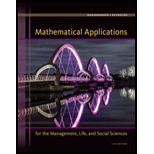
Problems 33-38 refer to closed Leontief models.
Suppose the technology matrix for a dosed model of a simple economy is given by matrix A. Find the gross productions for the industries.
Want to see the full answer?
Check out a sample textbook solution
Chapter 3 Solutions
Mathematical Applications for the Management, Life, and Social Sciences
- Answer the number questions with the following answers +/- 2 sqrt(2) +/- i sqrt(6) (-3 +/-3 i sqrt(3))/4 +/-1 +/- sqrt(6) +/- 2/3 sqrt(3) 4 -3 +/- 3 i sqrt(3)arrow_forward2. Answer the following questions. (A) [50%] Given the vector field F(x, y, z) = (x²y, e", yz²), verify the differential identity Vx (VF) V(V •F) - V²F (B) [50%] Remark. You are confined to use the differential identities. Let u and v be scalar fields, and F be a vector field given by F = (Vu) x (Vv) (i) Show that F is solenoidal (or incompressible). (ii) Show that G = (uvv – vVu) is a vector potential for F.arrow_forwardA driver is traveling along a straight road when a buffalo runs into the street. This driver has a reaction time of 0.75 seconds. When the driver sees the buffalo he is traveling at 44 ft/s, his car can decelerate at 2 ft/s^2 when the brakes are applied. What is the stopping distance between when the driver first saw the buffalo, to when the car stops.arrow_forward
- Topic 2 Evaluate S x dx, using u-substitution. Then find the integral using 1-x2 trigonometric substitution. Discuss the results! Topic 3 Explain what an elementary anti-derivative is. Then consider the following ex integrals: fed dx x 1 Sdx In x Joseph Liouville proved that the first integral does not have an elementary anti- derivative Use this fact to prove that the second integral does not have an elementary anti-derivative. (hint: use an appropriate u-substitution!)arrow_forward1. Given the vector field F(x, y, z) = -xi, verify the relation 1 V.F(0,0,0) = lim 0+ volume inside Se ff F• Nds SE where SE is the surface enclosing a cube centred at the origin and having edges of length 2€. Then, determine if the origin is sink or source.arrow_forward4 3 2 -5 4-3 -2 -1 1 2 3 4 5 12 23 -4 The function graphed above is: Increasing on the interval(s) Decreasing on the interval(s)arrow_forward
- Question 4 The plot below represents the function f(x) 8 7 3 pts O -4-3-2-1 6 5 4 3 2 + 1 2 3 5 -2+ Evaluate f(3) f(3) = Solve f(x) = 3 x= Question 5arrow_forwardQuestion 14 6+ 5 4 3 2 -8-2 2 3 4 5 6 + 2 3 4 -5 -6 The graph above is a transformation of the function f(x) = |x| Write an equation for the function graphed above g(x) =arrow_forwardQuestion 8 Use the graph of f to evaluate the following: 6 f(x) 5 4 3 2 1 -1 1 2 3 4 5 -1 t The average rate of change of f from 4 to 5 = Question 9 10 ☑ 4parrow_forward
- Question 15 ✓ 6 pts 1 Details The function shown below is f(x). We are interested in the transformed function g(x) = 3f(2x) - 1 a) Describe all the transformations g(x) has made to f(x) (shifts, stretches, etc). b) NEATLY sketch the transformed function g(x) and upload your graph as a PDF document below. You may use graph paper if you want. Be sure to label your vertical and horizontal scales so that I can tell how big your function is. 1- 0 2 3 4 -1- Choose File No file chosen Question 16 0 pts 1 Detailsarrow_forwardAND B A Ꭰarrow_forwardANBNC ND B こ Ꭰarrow_forward
 Linear Algebra: A Modern IntroductionAlgebraISBN:9781285463247Author:David PoolePublisher:Cengage Learning
Linear Algebra: A Modern IntroductionAlgebraISBN:9781285463247Author:David PoolePublisher:Cengage Learning
